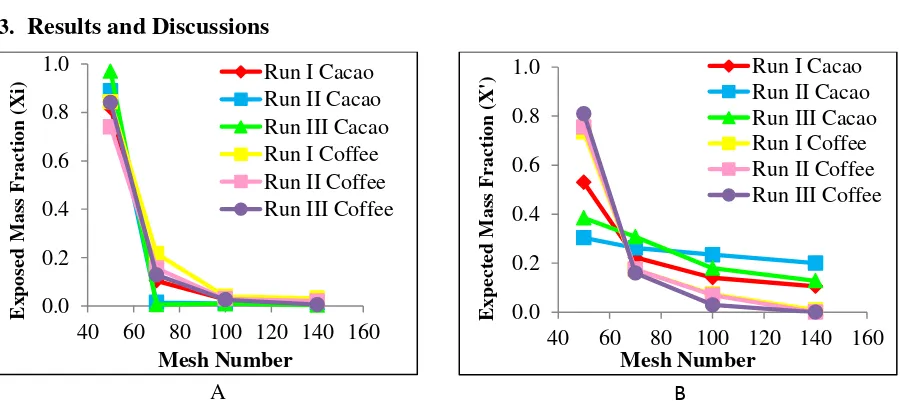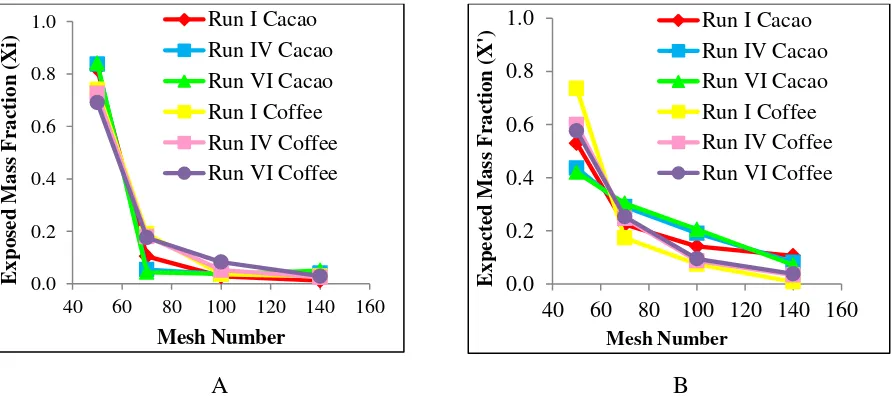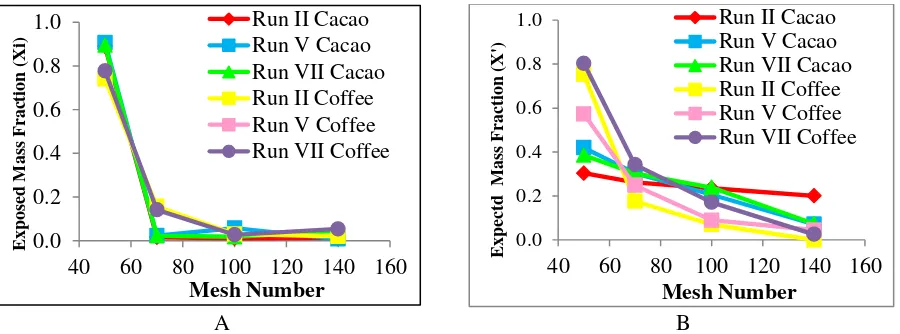PAPER • OPEN ACCESS
Ball mill tool for crushing coffee and cocoa beans
base on fraction size sieving results
To cite this article: B Haryanto et al 2018 IOP Conf. Ser.: Earth Environ. Sci.122 012091
View the article online for updates and enhancements.
Related content
Physical and sensory quality of Java Arabica green coffee beans
W B Sunarharum, S S Yuwono, N B S W Pangestu et al.
-Mechanical behaviour of Arabica coffee (Coffea arabica) beans under loading compression
R Sigalingging, D Herak, A Kabutey et al.
-A field survey on coffee beans drying methods of Indonesian small holder farmers
Parulian Siagian, Eko Y. Setyawan, Tumiur Gultom et al.
Content from this work may be used under the terms of theCreative Commons Attribution 3.0 licence. Any further distribution of this work must maintain attribution to the author(s) and the title of the work, journal citation and DOI.
Ball mill tool for crushing coffee and cocoa beans base on
fraction size sieving results
B Haryanto, M Sirait, M Azalea, Alvin, S E Cahyani
Universitas Sumatera Utara
Abstract. Crushing is one of the operation units that aimed to convert the size of solid material to be smoother particle’s size. The operation unit that can be used in this crushing is ball mill. The purpose of this study is to foresee the effect of raw material mass, grinding time, and the number of balls that are used in the ball mill tool related to the amount of raw material of coffee and cocoa beans. Solid material that has become smooth is then sieved with sieve mesh with size number: 50, 70, 100, and 140. It is in order to obtain the mass fraction that escaped from each sieve mesh. From the experiment, it can be concluded that mass percentage fraction of coffee powder is bigger than cocoa powder that escaped from the mesh. Hardness and humidity of coffee beans and cocoa beans have been the important factors that made coffee beans is easier to be crushed than cocoa beans.
1. Introduction
Indonesia is a one of cocoa and coffee producer in the world. Cocoa and Coffee have a unique characteristics, that were developed in Indonesia’s area. Indonesia has potential to improve the quality of cocoa beans into a product that can compete with other cocoa-producing countries [1]. Cocoa and coffee can contribute to increase the economic value to Indonesia. Coffee plants were introduced during the Dutch East Indies (now Indonesia) [2].
Cocoa have sorghum crystals in its components. Toughness of cocoa make more tasty when produces in indutrial operation processes and the toughness points of cocoa exists in conditional room temperature [1]. Meanwhile, Coffee have the skin contains the complex chemical substances. Physical changes in coffee during roasting include reduction in mass due to loss of moisture and decomposition of carbohydrates, increase the volume of coffee beans, lowering the density due to puffing and increase in brittleness. It is well known that during roasting, coffee beans lose their strength and toughness and become brittle and fragile [3].
Grinding in ball mills is an important technological process applied to reduce the size of particles, which may have different nature, and a wide diversity of physical, mechanical and chemical characteristics. However, ball mills have been widely applied in different fields such as the mining, chemical and pharmaceutical industries. One of the most popular ball mills is the tumbling ball mill, which consists of a rotating cylindrical drum with grinding media such as balls. The use of balls in the grinding of ores is a major item in the costs of milling operations [4]. Various factors like hardness, toughness, stickiness, slipperiness, moisture content, melting or softening point, abrasiveness and others (material structure, size, shape, flow, and bulk density of product) ratio of feed size to product size, affect the size reduction [5].
2 2. Material and Methods
The cocoa and coffee were washed by pure water then dried naturally in the hot sun temperature until really dry. Following the weight variation of sample, ingredients were prepared 30-50 grams. Then the sample put in the ball mill space. The certain number of balls as variation size was then put to the equipment ball mill space. The mill was then running at certain operation time 40-60 minutes. The crushing mill product was then taken and put in a container. The powdered products are weighed with laboratory balance to confirm with its initial weight. The product was then sieved using a mesh size of 50 70 100 140. Each mass that passes and is suspended is weighed as mass and recorded to obtain a fraction of mass escaped and retained. This procedure is repeated and done according to the variations in Tables 1 and 2.
Table 1. Ball mill sizes
Size Diameter Weight
Small (ceramic) 1.63 cm 16.06 gram
Medium (metal) 3.56 cm 123.17 gram
Big (ceramic) 5.97 cm 160.88 gram
Table 2. Variables measurement
Variable The range of variable Run times/Operation
Time
Weight of samples 30 – 50 gram 40-60 minutes
Type of ball mill Small, medium, big
3.
Results and Discussions
A B
Figure 1. Graph of Exposed Mass Fraction versus Mesh Number with Feed Weight Variations
p
Xi = retained mass fraction; Dp i= average particle diameter
From the equation can get the relationship of m (mass) and Xi (retained mass fraction).
Increasing the mass sample number will increase the fraction of masses retained. However,
the results for the cacao beans are not following the theories (equation 1 and 2). Increasing
the sample number was not in accordance, where more weight should be retained greater
mass fraction. It may a deviation on the sample of cacao bean for run II and run III.
A
B
Figure 2. Graph of Exposed Mass Fraction versus Mesh Number with Ball Sizes Variations
The effect of variation ball sizes such as: run I : 30 grams with 10 medium balls, 8 small balls for 40 minutes; run IV : 30 grams with 12 medium balls, 8 small balls for 40 minutes; run VI : 30 grams with 15 medium balls, 8 small balls for operation time 40 minutes. From Figure 2A and B, one can see the relationship of the retained mass fraction with the mesh number of the sieve used with the influence of the number of ball used. From the results obtained that the highest fractional mass fraction occurred in brown seed samples with the number of balls of 12 medium balls and 8 small balls and the mesh number was 50.
The relationship of mass fraction to the weight and size of the ball is:
4
The result show that with greater the weight of sample and the larger the size of the ball can decrease the sample size become smoother. It impacts positively to the less of mass fraction retained. The results obtained are not in accordance with existing theories especially on the sample of cocoa seeds for run I and run III. It should by increasing the number of balls used, the retained fraction of the mass should be decreased. The deviation may accure during operation steps.
A B
Figure 3. Graph of Exposed Mass Fraction versus Mesh Number with Operation Time Variations
The effect of variation operation time for run II : 40 grams sample with 10 medium balls and 8 small balls with variation operation time 40 minutes. Run V and VII with the same weight sample and ball
mill size and the operation time for 50 and 60 minutes respectively. The relationship of the
retained mass fraction with the mesh number of the sieve used with the influence of the
milling time is shown in Figure 3 A and B. One can see from the results obtained that the
highest fractured mass fraction occurred in cacao beans samples with 50 minutes grinding
operation time for 50 mesh number.
In theory, the relationship between fractured mass fractions and milling time can be written by the
fraction with i size of initial measure in mill at time t; bi,j = the next mass fraction at the crushing size
j.
From the results, it can be concluded that the longer the grinding operation time could produce smoother the resulting powder. The fraction of the retained masses sample will be less. However, the results obtained are not all in accordance with the existing theory. The increasing crushing operation time should increase the smaller sample fraction then decrease the retained mass of sample. The deviation was havening on the sample of cocoa beans and coffee beans both at runs I, II and III. The pretreatment of samples may impact the physical properties of the beans. The initial hardness and humidity of coffee and cocoa beans may be an important factor to crush to be smaller powder product [5]. The deviation results for this study may be infected by some aspect such as: the sample physical properties, operation control of the mill and human error. With different physical properties of both beans show that the coffee beans is easier to be crushed than cocoa beans. With tree variation in this investigation for crushing by ball mill type, weight of sample and operation time was possible to give the information about ability to decrease the sample size as the result after sieving the product.
4. Conclusion
Crushing by ball mill was possible to separate the materials base on the mess size after converting the size to be smoother particles. With the variation of sample weight was found that 30 gram sample is the best variation in comparing with coffee bean with sieve mesh with size number: 50 mesh. The balls type variation was shown that in using the 15 medium balls and 8 big balls size was possible to increase the fraction of coffee/ cocoa beans to be smoother size with sieve mesh with size number 70 mesh. Higher operation time was possible to convert the raw material of coffee/cocoa beans to become smaller in compare to coffee/cocoa beans with sieve mesh with size number 50 mesh. It was found that the most significant variation was 60 minutes. The physical properties of the hardness and humidity of coffee beans and cocoa beans have been the important factor that made coffee beans is easier to be crushed than cocoa beans.
Acknowledgment
The authors wish to express thankful to Unit Operation Laboratory of Chemical Engineering Department, Faculty of engineering USU in using the Ball Mill unit for this study.
References
[1] Badan Pusat Statistik 2015 https://www.bps.go.id
[2] D Teketay 1999 History, botany and ecological requirements of coffee Walia 20 28–50 [3] S Abrar; M Ali and S Endris 2014 Sky Journal of Agricultural Research 3(5) 82–88
[4] Ashgar, S Ziaeddin, M Noaprast and M Karamoozian 2015 Journal of Mining & Geophysics-Engineering 49(1) 83-91
[5] S Sushant and A Kamath. 2013 International Research Journal of Pharmacy 4(8) 57-64 [6] W L McCabe, JC Smith and PE Harriot 1993 Unit Operations of Chemical Engineering Fifth
Edition. McGraw-Hill


